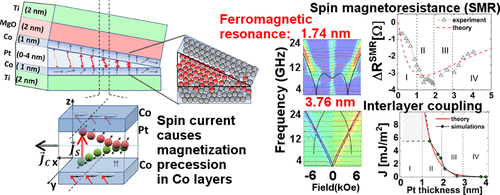当前位置:
X-MOL 学术
›
ACS Appl. Mater. Interfaces
›
论文详情
Our official English website, www.x-mol.net, welcomes your
feedback! (Note: you will need to create a separate account there.)
Study of Spin–Orbit Interactions and Interlayer Ferromagnetic Coupling in Co/Pt/Co Trilayers in a Wide Range of Heavy-Metal Thickness
ACS Applied Materials & Interfaces ( IF 8.3 ) Pub Date : 2021-09-24 , DOI: 10.1021/acsami.1c11675 Piotr Ogrodnik 1, 2 , Krzysztof Grochot 1, 3 , Łukasz Karwacki 4, 5 , Jarosław Kanak 1 , Michał Prokop 6 , Jakub Chȩciński 1 , Witold Skowroński 1 , Sławomir Ziȩtek 1 , Tomasz Stobiecki 1, 3
ACS Applied Materials & Interfaces ( IF 8.3 ) Pub Date : 2021-09-24 , DOI: 10.1021/acsami.1c11675 Piotr Ogrodnik 1, 2 , Krzysztof Grochot 1, 3 , Łukasz Karwacki 4, 5 , Jarosław Kanak 1 , Michał Prokop 6 , Jakub Chȩciński 1 , Witold Skowroński 1 , Sławomir Ziȩtek 1 , Tomasz Stobiecki 1, 3
Affiliation

|
The spin–orbit torque, a torque induced by a charge current flowing through the heavy-metal-conducting layer with strong spin–orbit interactions, provides an efficient way to control the magnetization direction in heavy-metal/ferromagnet nanostructures, required for applications in the emergent magnetic technologies like random access memories, high-frequency nano-oscillators, or bioinspired neuromorphic computations. We study the interface properties, magnetization dynamics, magnetostatic features, and spin–orbit interactions within the multilayer system Ti(2)/Co(1)/Pt(0–4)/Co(1)/MgO(2)/Ti(2) (thicknesses in nanometers) patterned by optical lithography on micrometer-sized bars. In the investigated devices, Pt is used as a source of the spin current and as a nonmagnetic spacer with variable thickness, which enables the magnitude of the interlayer ferromagnetic exchange coupling to be effectively tuned. We also find the Pt thickness-dependent changes in magnetic anisotropies, magnetoresistances, effective Hall angles, and, eventually, spin–orbit torque fields at interfaces. The experimental findings are supported by the relevant interface structure-related simulations, micromagnetic, macrospin, as well as the spin drift-diffusion models. Finally, the contribution of the spin–orbital Edelstein–Rashba interfacial fields is also briefly discussed in the analysis.
中文翻译:

大范围重金属厚度的 Co/Pt/Co 三层自旋轨道相互作用和层间铁磁耦合的研究
自旋轨道扭矩是由流过具有强自旋轨道相互作用的重金属导电层的电荷电流引起的扭矩,提供了一种有效的方法来控制重金属/铁磁体纳米结构中的磁化方向,适用于以下领域的应用新兴的磁性技术,如随机存取存储器、高频纳米振荡器或仿生神经形态计算。我们研究了多层系统 Ti(2)/Co(1)/Pt(0–4)/Co(1)/MgO(2)/Ti( 2)(以纳米为单位的厚度)通过光学光刻在微米尺寸的棒上图案化。在所研究的器件中,Pt 用作自旋电流源和厚度可变的非磁性隔离物,这使得层间铁磁交换耦合的幅度能够被有效地调整。我们还发现了 Pt 厚度相关的磁各向异性、磁阻、有效霍尔角以及最终界面处的自旋轨道扭矩场的变化。实验结果得到了相关界面结构相关模拟、微磁、宏自旋以及自旋漂移扩散模型的支持。最后,分析中还简要讨论了自旋轨道 Edelstein-Rashba 界面场的贡献。实验结果得到了相关界面结构相关模拟、微磁、宏自旋以及自旋漂移扩散模型的支持。最后,分析中还简要讨论了自旋轨道 Edelstein-Rashba 界面场的贡献。实验结果得到了相关界面结构相关模拟、微磁、宏自旋以及自旋漂移扩散模型的支持。最后,分析中还简要讨论了自旋轨道 Edelstein-Rashba 界面场的贡献。
更新日期:2021-10-06
中文翻译:

大范围重金属厚度的 Co/Pt/Co 三层自旋轨道相互作用和层间铁磁耦合的研究
自旋轨道扭矩是由流过具有强自旋轨道相互作用的重金属导电层的电荷电流引起的扭矩,提供了一种有效的方法来控制重金属/铁磁体纳米结构中的磁化方向,适用于以下领域的应用新兴的磁性技术,如随机存取存储器、高频纳米振荡器或仿生神经形态计算。我们研究了多层系统 Ti(2)/Co(1)/Pt(0–4)/Co(1)/MgO(2)/Ti( 2)(以纳米为单位的厚度)通过光学光刻在微米尺寸的棒上图案化。在所研究的器件中,Pt 用作自旋电流源和厚度可变的非磁性隔离物,这使得层间铁磁交换耦合的幅度能够被有效地调整。我们还发现了 Pt 厚度相关的磁各向异性、磁阻、有效霍尔角以及最终界面处的自旋轨道扭矩场的变化。实验结果得到了相关界面结构相关模拟、微磁、宏自旋以及自旋漂移扩散模型的支持。最后,分析中还简要讨论了自旋轨道 Edelstein-Rashba 界面场的贡献。实验结果得到了相关界面结构相关模拟、微磁、宏自旋以及自旋漂移扩散模型的支持。最后,分析中还简要讨论了自旋轨道 Edelstein-Rashba 界面场的贡献。实验结果得到了相关界面结构相关模拟、微磁、宏自旋以及自旋漂移扩散模型的支持。最后,分析中还简要讨论了自旋轨道 Edelstein-Rashba 界面场的贡献。











































 京公网安备 11010802027423号
京公网安备 11010802027423号